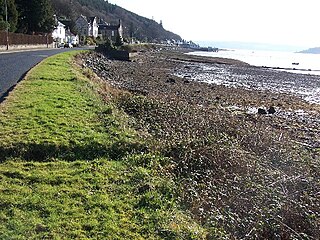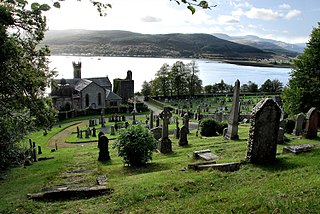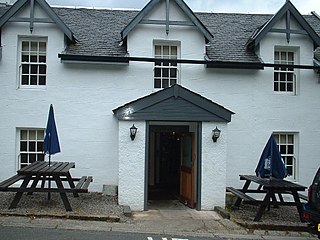
Dunoon is the main town on the Cowal peninsula in the south of Argyll and Bute, Scotland. It is located on the western shore of the upper Firth of Clyde, to the south of the Holy Loch and to the north of Innellan. As well as forming part of the council area of Argyll and Bute, Dunoon also has its own community council. Dunoon was a burgh until 1976.

The Holy Loch is a sea loch, a part of the Cowal peninsula coast of the Firth of Clyde, in Argyll and Bute, Scotland.

Loch Long is a body of water in Argyll and Bute, Scotland. The Sea Loch extends from the Firth of Clyde at its southwestern end. It measures approximately 20 miles in length, with a width of between one and two miles. The loch also has an arm, Loch Goil, on its western side.

Kilmun is a linear settlement on the north shore of the Holy Loch, on the Cowal peninsula in Argyll and Bute, Scottish Highlands.It takes its name from the 7th century monastic community founded by an Irish monk, St Munn. The ruin of a 12th-century church still stands beside the Kilmun Parish Church and Argyll Mausoleum.

Strone is a village on the Cowal peninsula in Argyll and Bute in the Scottish Highlands at the point where the north shore of the Holy Loch becomes the west shore of the Firth of Clyde. The village lies within the Loch Lomond and The Trossachs National Park.

Ardnadam is a village on the Holy Loch on the Cowal peninsula, Argyll and Bute, Scotland. It is located northwest of Hunters Quay and east of Sandbank, and sits across the loch from Kilmun.

Hunters Quay is a village, on the Cowal peninsula in Argyll and Bute, Scottish Highlands. Situated between Kirn to the south and Ardnadam to the north, Hunters Quay is the main base of Western Ferries, operating between Hunters Quay and McInroy's Point.

Dunoon Castle is a ruined castle located at Dunoon on the Cowal peninsula in Argyll and Bute, Scotland. The castle sat upon a cone-shaped hill of about 80 feet high, a volcanic plug. Very little remains of the castle's structure today. Castle House, built in 1822, stands a few yards north of the castle ruins.

Kilmun Parish Church and Argyll Mausoleum in Kilmun, Argyll and Bute, Scotland, consists of St Munn's Church, as well as the adjacent mausoleum of the Dukes of Argyll and a historically significant churchyard. The complex is located on the summit of a slight knoll about ten metres from the shoreline of the Holy Loch on the Cowal Peninsula in Argyll, Scotland. The existing church dates from 1841 and occupies the site of an older, medieval church. A partly ruined tower from the medieval period still stands to the west of the present building.

Dunoon Primary School is a school in Dunoon, Argyll and Bute, Scotland. It is located in a Category B listed building dating from 1901.

St John's Church, formerly Dunoon Free Church, is a Presbyterian church building in Dunoon, Argyll and Bute, Scotland. A Category A listed structure, it is located in the town centre at the junction between Hanover Street and Victoria Road. The church is still in daily use.

Glen Lean is on the Cowal peninsula in Argyll and Bute, Scotland. It is an obvious glacial-formed glen, with near vertical sides along part of the glen. It runs from the head of the Holy Loch in the east to the head of Loch Striven in the west. The only hamlet in the glen is Clachaig. The Little Eachaig River flows out of the glen, joining the River Eachaig and flows into the Holy Loch. The Tarsan Dam is the other notable feature in the glen.

Loch Loskin is a freshwater loch in Ardnadam, Argyll and Bute, Scotland. The outflow from the loch is the Milton Burn, which winds its way through Dunoon to the Firth of Clyde. The A885 from Sandbank known as the "High Road" locally passes the loch.

Mackintosh MacKay was a Scottish minister and author who served as Moderator of the General Assembly of the Free Church of Scotland in 1849. He edited the Highland Society's prodigious Gaelic dictionary in 1828.

The Whistlefield Inn is a Category C listed building in Whistlefield, Argyll and Bute, Scotland, about twelve miles northwest of Dunoon. Built in 1663, it was originally a drover's inn on the route between Strachur and Ardentinny. It sits about 1,300 feet (400 m) from the eastern shores of Loch Eck. Today, it is an inn and restaurant.

High Kirk, also known as the Old Parish Church, is a Church of Scotland church building in Dunoon, Argyll and Bute, Scotland. It is located on Kirk Street, just south of the town centre. Constructed in the Gothic revival style, it is a Category B listed building.

The Queen's Hotel was a hotel located on Marine Parade in Kirn, Argyll and Bute, Scotland. Now a private residence, it is a Category C listed building, dating to around 1859. Its first proprietor was Mrs Urquhart.

William FraserRIBA was a Scottish-born architect, prominent in the late 19th and early 20th centuries, who initially practised in Great Britain and then in Canada until his death in 1922.

Dunoon Pier is a Victorian pier in the Scottish town of Dunoon, Argyll and Bute. Completed in its current form in 1898, and reaching out into the Firth of Clyde, its earliest parts date back to 1835. It is now a Category A listed structure and, according to Historic Environment Scotland, the best surviving example of a timber ferry pier in Scotland.



















